I am loading a sample gltf 2.0 model into my Vulkan program using a custom parser, everything loads fine except that on this particular 3d model (which is a bath duck model found on gltf 2.0 github page), the beak of the duck seems to be failing the depth testing.
the duck should look like this
However in my program it looks like this

here is the duck from another angle

Note that i have not applied the projection matrix yet, and i am inverting the y component of the model matrix as well as setting my front face to counter clockwise
Vulkan pipeline initialization
void phantom::createGraphicsPipeline()
{
auto vertShaderCode = readFile("shaders/vert.spv");
auto fragShaderCode = readFile("shaders/frag.spv");
createShaderModule(vertShaderCode, vertShaderModule);
createShaderModule(fragShaderCode, fragShaderModule);
VkPipelineShaderStageCreateInfo vertShaderStageInfo = {};
vertShaderStageInfo.sType = VK_STRUCTURE_TYPE_PIPELINE_SHADER_STAGE_CREATE_INFO;
vertShaderStageInfo.stage = VK_SHADER_STAGE_VERTEX_BIT;
vertShaderStageInfo.module = vertShaderModule;
vertShaderStageInfo.pName = "main";
VkPipelineShaderStageCreateInfo fragShaderStageInfo = {};
fragShaderStageInfo.sType = VK_STRUCTURE_TYPE_PIPELINE_SHADER_STAGE_CREATE_INFO;
fragShaderStageInfo.stage = VK_SHADER_STAGE_FRAGMENT_BIT;
fragShaderStageInfo.module = fragShaderModule;
fragShaderStageInfo.pName = "main";
VkPipelineShaderStageCreateInfo shaderStages[] = { vertShaderStageInfo, fragShaderStageInfo };
//auto bindingDescription = getBindingDescription();
//auto attributeDescription = getAttributeDescription();
VkPipelineVertexInputStateCreateInfo vertexInputInfo = {};
vertexInputInfo.sType = VK_STRUCTURE_TYPE_PIPELINE_VERTEX_INPUT_STATE_CREATE_INFO;
vertexInputInfo.vertexBindingDescriptionCount = static_cast<uint32_t> (vertexBinding.size());
vertexInputInfo.pVertexBindingDescriptions = vertexBinding.data();
vertexInputInfo.vertexAttributeDescriptionCount = static_cast<uint32_t>(vertexAttributes.size());
vertexInputInfo.pVertexAttributeDescriptions = vertexAttributes.data();
VkPipelineInputAssemblyStateCreateInfo inputAssembly = {};
inputAssembly.sType = VK_STRUCTURE_TYPE_PIPELINE_INPUT_ASSEMBLY_STATE_CREATE_INFO;
inputAssembly.topology = VK_PRIMITIVE_TOPOLOGY_TRIANGLE_LIST;
inputAssembly.primitiveRestartEnable = VK_FALSE;
VkViewport viewport = {};
viewport.x = 0.0f;
viewport.y = 0.0f;
viewport.width = (float)swapChainExtend.width;
viewport.height = (float)swapChainExtend.height;
viewport.minDepth = 0.0f;
viewport.maxDepth = 1.0f;
VkRect2D scissor = {};
scissor.offset = { 0,0 };
scissor.extent = swapChainExtend;
VkPipelineViewportStateCreateInfo viewportState = {};
viewportState.sType = VK_STRUCTURE_TYPE_PIPELINE_VIEWPORT_STATE_CREATE_INFO;
viewportState.viewportCount = 1;
viewportState.pViewports = &viewport;
viewportState.scissorCount = 1;
viewportState.pScissors = &scissor;
VkPipelineRasterizationStateCreateInfo rasterizer = {};
rasterizer.sType = VK_STRUCTURE_TYPE_PIPELINE_RASTERIZATION_STATE_CREATE_INFO;
rasterizer.depthClampEnable = VK_FALSE;
rasterizer.rasterizerDiscardEnable = VK_FALSE;
rasterizer.polygonMode = VK_POLYGON_MODE_FILL;
rasterizer.lineWidth = 1.0f;
rasterizer.cullMode = VK_CULL_MODE_BACK_BIT;
rasterizer.frontFace = VK_FRONT_FACE_COUNTER_CLOCKWISE;
rasterizer.depthBiasEnable = VK_FALSE;
rasterizer.depthBiasConstantFactor = 0.0f;
rasterizer.depthBiasClamp = 0.0f;
rasterizer.depthBiasSlopeFactor = 0.0f;
VkPipelineMultisampleStateCreateInfo multisampling = {};
multisampling.sType = VK_STRUCTURE_TYPE_PIPELINE_MULTISAMPLE_STATE_CREATE_INFO;
multisampling.sampleShadingEnable = VK_FALSE;
multisampling.rasterizationSamples = VK_SAMPLE_COUNT_1_BIT;
multisampling.minSampleShading = 1.0f;
multisampling.pSampleMask = nullptr;
multisampling.alphaToCoverageEnable = VK_FALSE;
multisampling.alphaToOneEnable = VK_FALSE;
VkPipelineDepthStencilStateCreateInfo depthStencil = {};
depthStencil.sType = VK_STRUCTURE_TYPE_PIPELINE_DEPTH_STENCIL_STATE_CREATE_INFO;
depthStencil.depthTestEnable = VK_TRUE;
depthStencil.depthWriteEnable = VK_TRUE;
depthStencil.depthCompareOp = VK_COMPARE_OP_LESS;
depthStencil.depthBoundsTestEnable = VK_FALSE;
depthStencil.minDepthBounds = 0.0f;
depthStencil.maxDepthBounds = 1.0f;
depthStencil.stencilTestEnable = VK_FALSE;
depthStencil.front = {};
depthStencil.back = {};
VkPipelineColorBlendAttachmentState colorBlendAttachment = {};
colorBlendAttachment.colorWriteMask = VK_COLOR_COMPONENT_R_BIT | VK_COLOR_COMPONENT_G_BIT | VK_COLOR_COMPONENT_B_BIT | VK_COLOR_COMPONENT_A_BIT;
colorBlendAttachment.blendEnable = VK_FALSE;
colorBlendAttachment.srcColorBlendFactor = VK_BLEND_FACTOR_ONE;
colorBlendAttachment.dstColorBlendFactor = VK_BLEND_FACTOR_ZERO;
colorBlendAttachment.colorBlendOp = VK_BLEND_OP_ADD;
colorBlendAttachment.srcAlphaBlendFactor = VK_BLEND_FACTOR_ONE;
colorBlendAttachment.dstAlphaBlendFactor = VK_BLEND_FACTOR_ZERO;
colorBlendAttachment.alphaBlendOp = VK_BLEND_OP_ADD;
VkPipelineColorBlendStateCreateInfo colorBlending = {};
colorBlending.sType = VK_STRUCTURE_TYPE_PIPELINE_COLOR_BLEND_STATE_CREATE_INFO;
colorBlending.logicOpEnable = VK_FALSE;
colorBlending.logicOp = VK_LOGIC_OP_COPY;
colorBlending.attachmentCount = 1;
colorBlending.pAttachments = &colorBlendAttachment;
colorBlending.blendConstants[0] = 0.0f;
colorBlending.blendConstants[1] = 0.0f;
colorBlending.blendConstants[2] = 0.0f;
colorBlending.blendConstants[3] = 0.0f;
VkDynamicState dynamicStates[] = {
VK_DYNAMIC_STATE_VIEWPORT,
VK_DYNAMIC_STATE_LINE_WIDTH
};
VkPipelineDynamicStateCreateInfo dynamicState = {};
dynamicState.sType = VK_STRUCTURE_TYPE_PIPELINE_DYNAMIC_STATE_CREATE_INFO;
dynamicState.dynamicStateCount = 2;
dynamicState.pDynamicStates = dynamicStates;
VkDescriptorSetLayout setLayouts[] = { descriptorSetLayout };
VkPipelineLayoutCreateInfo pipelineLayoutInfo = {};
pipelineLayoutInfo.sType = VK_STRUCTURE_TYPE_PIPELINE_LAYOUT_CREATE_INFO;
pipelineLayoutInfo.setLayoutCount = 1;
pipelineLayoutInfo.pSetLayouts = setLayouts;
pipelineLayoutInfo.pushConstantRangeCount = 0;
pipelineLayoutInfo.pPushConstantRanges = 0;
if (vkCreatePipelineLayout(device, &pipelineLayoutInfo, nullptr, &pipelineLayout) != VK_SUCCESS)
{
throw std::runtime_error("failed to create pipeline layout !");
}
VkGraphicsPipelineCreateInfo pipelineInfo = {};
pipelineInfo.sType = VK_STRUCTURE_TYPE_GRAPHICS_PIPELINE_CREATE_INFO;
pipelineInfo.stageCount = 2;
pipelineInfo.pStages = shaderStages;
pipelineInfo.pVertexInputState = &vertexInputInfo;
pipelineInfo.pInputAssemblyState = &inputAssembly;
pipelineInfo.pViewportState = &viewportState;
pipelineInfo.pRasterizationState = &rasterizer;
pipelineInfo.pMultisampleState = &multisampling;
pipelineInfo.pDepthStencilState = &depthStencil;
pipelineInfo.pColorBlendState = &colorBlending;
pipelineInfo.pDynamicState = nullptr;
pipelineInfo.layout = pipelineLayout;
pipelineInfo.renderPass = renderPass;
pipelineInfo.subpass = 0;
pipelineInfo.basePipelineHandle = VK_NULL_HANDLE;
pipelineInfo.basePipelineIndex = -1;
if (vkCreateGraphicsPipelines(device, VK_NULL_HANDLE, 1, &pipelineInfo, nullptr, &graphicsPipeline) != VK_SUCCESS)
{
throw std::runtime_error("failed to create graphics pipeline! ");
}
}
transformation matrix fed to the command buffer
glm::mat4 rotationMat = glm::rotate(10.f,glm::vec3(0,1,0));
glm::mat4 translateMat = glm::translate(glm::vec3(0, 0, 0));
glm::mat4 scaleMat = glm::scale(glm::vec3(30, 30, 30));
glm::mat4 modelMat = v.model.transformation[0] * scaleMat * rotationMat;
//v.model.transformation[0] = rotationMat * v.model.transformation[0];
modelMat[1][1] = modelMat[1][1] * -1;
v.updateUniformBuffer(modelMat);
depth resource and renderpass creation debug messages

Render pass creation method
void phantom::createRenderPass()
{
std::cout << "entered renderpass creation" << std::endl;
VkAttachmentDescription colorAttachment = {};
colorAttachment.format = swapChainImageFormat;
colorAttachment.samples = VK_SAMPLE_COUNT_1_BIT;
colorAttachment.loadOp = VK_ATTACHMENT_LOAD_OP_CLEAR;
colorAttachment.storeOp = VK_ATTACHMENT_STORE_OP_STORE;
colorAttachment.stencilLoadOp = VK_ATTACHMENT_LOAD_OP_DONT_CARE;
colorAttachment.stencilStoreOp = VK_ATTACHMENT_STORE_OP_DONT_CARE;
colorAttachment.initialLayout = VK_IMAGE_LAYOUT_UNDEFINED;
colorAttachment.finalLayout = VK_IMAGE_LAYOUT_PRESENT_SRC_KHR;
VkAttachmentReference colorAttachmentRef = {};
colorAttachmentRef.attachment = 0;
colorAttachmentRef.layout = VK_IMAGE_LAYOUT_COLOR_ATTACHMENT_OPTIMAL;
VkAttachmentDescription depthAttachment = {};
depthAttachment.format = findDepthFormat();
depthAttachment.samples = VK_SAMPLE_COUNT_1_BIT;
depthAttachment.loadOp = VK_ATTACHMENT_LOAD_OP_CLEAR;
depthAttachment.storeOp = VK_ATTACHMENT_STORE_OP_DONT_CARE;
depthAttachment.stencilLoadOp = VK_ATTACHMENT_LOAD_OP_DONT_CARE;
depthAttachment.stencilStoreOp = VK_ATTACHMENT_STORE_OP_DONT_CARE;
depthAttachment.initialLayout = VK_IMAGE_LAYOUT_DEPTH_STENCIL_ATTACHMENT_OPTIMAL;
depthAttachment.finalLayout = VK_IMAGE_LAYOUT_DEPTH_STENCIL_ATTACHMENT_OPTIMAL;
VkAttachmentReference depthAttachmentRef = {};
depthAttachmentRef.attachment = 1;
depthAttachmentRef.layout = VK_IMAGE_LAYOUT_DEPTH_STENCIL_ATTACHMENT_OPTIMAL;
VkSubpassDescription subPass = {};
subPass.pipelineBindPoint = VK_PIPELINE_BIND_POINT_GRAPHICS;
subPass.colorAttachmentCount = 1;
subPass.pColorAttachments = &colorAttachmentRef;
subPass.pDepthStencilAttachment = &depthAttachmentRef;
std::vector <VkAttachmentDescription> attachments = { colorAttachment, depthAttachment };
VkRenderPassCreateInfo renderPassInfo = {};
renderPassInfo.sType = VK_STRUCTURE_TYPE_RENDER_PASS_CREATE_INFO;
renderPassInfo.attachmentCount = attachments.size();
renderPassInfo.pAttachments = attachments.data();
renderPassInfo.subpassCount = 1;
renderPassInfo.pSubpasses = &subPass;
VkSubpassDependency dependency = {};
dependency.srcSubpass = VK_SUBPASS_EXTERNAL;
dependency.dstSubpass = 0;
dependency.srcStageMask = VK_PIPELINE_STAGE_BOTTOM_OF_PIPE_BIT;
dependency.srcAccessMask = VK_ACCESS_MEMORY_READ_BIT;
dependency.dstStageMask = VK_PIPELINE_STAGE_COLOR_ATTACHMENT_OUTPUT_BIT;
dependency.dstAccessMask = VK_ACCESS_COLOR_ATTACHMENT_READ_BIT | VK_ACCESS_COLOR_ATTACHMENT_WRITE_BIT;
renderPassInfo.dependencyCount = 1;
renderPassInfo.pDependencies = &dependency;
if (vkCreateRenderPass(device, &renderPassInfo, nullptr, &renderPass) != VK_SUCCESS)
{
throw std::runtime_error("failed to create render pass ! ");
}
}
FrameBuffer Creation method
void phantom::createFrameBuffer()
{
swapChainFramebuffers.resize(swapChainImageViews.size());
for (size_t i = 0; i < swapChainImageViews.size(); i++)
{
std::vector<VkImageView> attachments = { swapChainImageViews[i], depthImageView };
VkFramebufferCreateInfo framebufferInfo = {};
framebufferInfo.sType = VK_STRUCTURE_TYPE_FRAMEBUFFER_CREATE_INFO;
framebufferInfo.renderPass = renderPass;
framebufferInfo.attachmentCount = attachments.size();
framebufferInfo.pAttachments = attachments.data();
framebufferInfo.width = swapChainExtend.width;
framebufferInfo.height = swapChainExtend.height;
framebufferInfo.layers = 1;
if (vkCreateFramebuffer(device, &framebufferInfo, nullptr, &swapChainFramebuffers[i]) != VK_SUCCESS)
{
throw std::runtime_error("failed to create framebuffer!");
}
}
}

